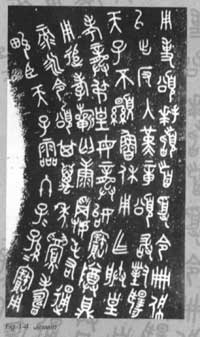The following year, a merchant named Wang Yirong developed an interest in the shells, and went to Henan to collect more of them. Later, a scholar, Liu Er, continued the collection. They collected more than 5,000 pieces, which were given the name ofJiaguwen(scripts on tortoise shells and animal bones).
|

|
|
Jinwen
|
Philologists, who subsequently carried out research on more than 100000 shell and bone pieces, found out the structure of
Jiaguwenhad changed into legible characters complete with recognized signs. The shell and bone writing had developed a certain degree of maturity. Of the more than 4,600 distinct characters in these pieces, some 1,700 were later identified.
Developing a little later thanJiaguwenwere theJinwen(script on metal). These were characters inscribed onbronzewareduring the late Shang and early Zhou (1100-770BC) dynasties, which are known as theBronzeAge.Jinwenis also known as Zhongdingwen, a name deriving from the ding (tripod), a typical ceremonial instrument, and the Zhong (bell), which symbolizesmusical instruments. The name Zhongdingwen is synonymous with bronze ware.
TheJinwenon bronze recorded important events and activities and reflected the social life of the time. The calligraphic style ofJinwenis delicate, simple and dignified. Compared withJiaguwen, it has richer variations and content.Jinwencharacters were first discovered in theHan Dynastywhen a ding was discovered in Fenyang,Shanxi Province, and sent to the imperial palace. Other bronze objects inscribed withJinwenwere unearthed later. Song Dynasty (960-1279) intellectuals Ouyang Xiu and Zhao Mingcheng were good at writing and researchingJinwen.
TheJinwenon the Duke Mao Ding made during theZhou Dynastyis the most representative of thecalligraphyof the period. The inscription of some 497 characters in 32 lines recorded the political situation of that time, and how Duke Mao had offered his loyal services to the Emperor and helped him overcome difficulties. It has the longest inscriptions among the bronzeware attributed to that era; the structure of the characters is neat and the strokes thin and long. The inscriptions on the Dayu Ding and Sanpan Ding are also good examples ofJinwen.
